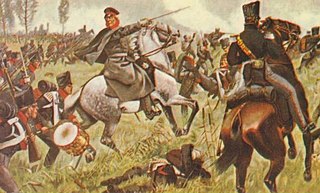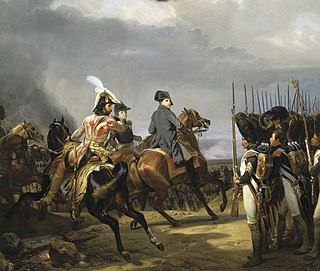
The Battle of Ocaña was fought on 19 November 1809 between French forces under Marshal Jean de Dieu Soult, Duke of Dalmatia and King Joseph Bonaparte and the Spanish army under Juan Carlos de Aréizaga, which suffered its greatest single defeat in the Peninsular War. General Juan Carlos de Aréizaga's Spanish army of 51,000 lost nearly 19,000 killed, wounded, prisoners and deserters, mostly due to the French use of their cavalry. Tactically, the battle was a Cannae-like encirclement of the Spanish army, and the worst defeat ever suffered by a Spanish army on home soil. The strategic consequences were also devastating, as it destroyed the only force capable of defending southern Spain; the area was overrun over the winter in the Andalusia campaign.

The Battle of Pułtusk took place on 26 December 1806 during the War of the Fourth Coalition near Pułtusk, Poland. Despite their strong numerical superiority and artillery, the Russians suffered the French attacks, before retiring the next day having suffered greater losses than the French, disorganizing their army for the rest of the year.

The Russian Imperial Guard, officially known as the Leib Guard were military units serving as personal guards of the Emperor of Russia. Peter the Great founded the first such units following the Prussian practice in 1683, to replace the politically motivated Streltsy. The Imperial Guard subsequently increased in size and diversity to become an elite corps of all branches within the Imperial Army rather than Household troops in direct attendance on the Tsar. Numerous links were however maintained with the Imperial family and the bulk of the regiments of the Imperial Guard were stationed in and around Saint Petersburg in peacetime. The Imperial Guard was disbanded in 1917 following the Russian Revolution.
This is the complete order of battle of the French and Third Coalition armies during the Battle of Austerlitz.
This is the complete order of battle of opposing forces at the Battle of Balaclava.

The Essex Yeomanry was a Reserve unit of the British Army that originated in 1797 as local Yeomanry Cavalry Troops in Essex. Reformed after the experience gained in the Second Boer War, it saw active service as cavalry in World War I and as artillery in World War II. Its lineage is maintained by 36 Signal Squadron, part of 71 (Yeomanry) Signal Regiment, Royal Corps of Signals.

The Combat of the Côa was a military engagement that occurred during the Peninsular War period of the Napoleonic Wars. It took place in the valley of the Côa River and it was the first significant battle for the new army of 65,000 men controlled by Marshal André Masséna, as the French prepared for their third invasion of Portugal.

The Battle of Wartenburg took place on 3 October 1813 between the French IV Corps commanded by General Henri Gatien Bertrand and the Allied Army of Silesia, principally the I Corps of General Ludwig von Yorck. The battle allowed the Army of Silesia to cross the Elbe, ultimately leading to the Battle of Leipzig.
The following units of the German First Army and British Expeditionary Force fought in the Battle of Mons in World War I.
This is an order of battle of the French and German Armies at the beginning of the Franco-Prussian War in 1870.

The Battle of Lübeck took place on 6 November 1806 in Lübeck, Germany between soldiers of the Kingdom of Prussia led by Gebhard Leberecht von Blücher, who were retreating from defeat at the Battle of Jena–Auerstedt, and troops of the First French Empire under Marshals Murat, Bernadotte, and Soult, who were pursuing them. In this War of the Fourth Coalition action, the French inflicted a severe defeat on the Prussians, driving them from the neutral city. Lübeck is an old Baltic Sea port approximately 50 kilometres (31 mi) northeast of Hamburg.
This is the order of battle for the ground forces involved in Operation Crusader, a World War II battle between the British Commonwealth and the European Axis Powers of Germany and Italy in North Africa between 18 November – 30 December 1941.
The Army of the Danube was a field army of the Russian Empire, created for the Russo-Turkish War of 1806–1812.

The Battle of Neumarkt-Sankt Veit on 24 April 1809 saw a Franco-Bavarian force led by Marshal Jean-Baptiste Bessières face an Austrian Empire army commanded by Johann von Hiller. Hiller's numerically superior force won a victory over the Allied troops, forcing Bessières to retreat to the west. Neumarkt-Sankt Veit is located ten kilometers north of Mühldorf and 33 kilometers southeast of Landshut in Bavaria.

The Jena-Auerstedt campaign order of battle is listed below. The order of battle includes units from the First French Empire and the Kingdom of Prussia that fought each other in the campaign that included the decisive Battle of Jena-Auerstedt on 14 October 1806. The order of battle may be useful to trace the battles of Schleiz and Saalfeld, which occurred before Jena-Auerstedt, as well as battles and capitulations that happened after 14 October, such as Erfurt, Halle, Prenzlau, Pasewalk, Stettin, Waren-Nossentin, and Lübeck.

In the Battle of Mohrungen on 25 January 1807, most of a First French Empire corps under the leadership of Marshal Jean-Baptiste Bernadotte fought a strong Russian Empire advance guard led by Major General Yevgeni Ivanovich Markov. The French pushed back the main Russian force, but a cavalry raid on the French supply train caused Bernadotte to call off his attacks. After driving off the cavalry, Bernadotte withdrew and the town was occupied by the army of General Levin August, Count von Bennigsen. The fighting took place in and around Morąg in northern Poland, which in 1807 was the East Prussian town of Mohrungen. The action was part of the War of the Fourth Coalition in the Napoleonic Wars.

The Battle of Czarnowo on the night of 23–24 December 1806 saw troops of the First French Empire under the eye of Emperor Napoleon I launch an evening assault crossing of the Wkra River against Lieutenant General Alexander Ivanovich Ostermann-Tolstoy's defending Russian Empire forces. The attackers, part of Marshal Louis-Nicolas Davout's III Corps, succeeded in crossing the Wkra at its mouth and pressed eastward to the village of Czarnowo. After an all-night struggle, the Russian commander withdrew his troops to the east, ending this War of the Fourth Coalition action. Czarnowo is located on the north bank of the Narew River 33 kilometres (21 mi) north-northwest of Warsaw, Poland.
The II Cavalry Corps of the Grande Armée was a French military unit that existed during the Napoleonic Wars. It was first formed in December 1806, but only enjoyed a brief existence under Marshal Jean-Baptiste Bessières. The II Cavalry Corps was reconstituted for the invasion of Russia in 1812 and commanded by General Louis-Pierre Montbrun who was killed in battle, as was his successor a few hours later. During the War of the Sixth Coalition, General Horace François Bastien Sébastiani de La Porta led the II Cavalry Corps in 1813, while General Antoine-Louis Decrest de Saint-Germain led the corps in 1814. During the Hundred Days, Emperor Napoleon Bonaparte raised the corps again and entrusted it to General Rémi Joseph Isidore Exelmans.
The VII Corps of the Grande Armée was a French military unit that existed during the Napoleonic Wars. It was formed in 1805 and assigned to Marshal Pierre Augereau. From 1805 to 1807, Augereau led the VII Corps in the War of the Third Coalition and the War of the Fourth Coalition. It was disbanded after being nearly wiped out at the Battle of Eylau in February 1807 and its surviving troops were distributed to other corps.
The Reserve Cavalry Corps or Cavalry Reserve of the Grande Armée was a French military unit that existed during the Napoleonic Wars. In 1805, Emperor Napoleon Bonaparte appointed Marshal Joachim Murat to command all the cavalry divisions that were not directly attached to the army corps. During the Ulm campaign, Murat led his horsemen in successfully hunting down many Austrian units that escaped the capitulation of Ulm, before fighting at Austerlitz in December 1805. Under Murat, the Cavalry Reserve played a prominent role in the destruction of the Prussian armies after the Battle of Jena-Auerstedt in 1806. In 1812, the Reserve Cavalry Corps was split up into the I, II, III, and IV Cavalry Corps for the French invasion of Russia.